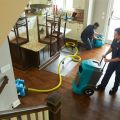9/10/2020
Classes and Categories of Water Damage
11/25/2020
Water damage is a common and recurring problem in homes and businesses, but dealing with it can still be a daunting task every time. Water damage can stem from normal disruptions like broken pipes, leaking faucets, or damaged appliances to natural calamities like heavy rain and intense flooding, but no matter how big or small the damage is, it is vital to deal with it immediately to prevent further losses.
The first thing that comes to mind when water damage is involved is to try to handle it on one’s own, but often this only leads to a bigger problem especially if the one performing the task is untrained. Water damage comes in different classes and categories and each requires special techniques and equipment for proper extraction, a job that can only be handled by an expert water damage restoration company such as ServiceMaster of the Upstate. Below are the classes and categories of water damage that home and business owners may encounter.
Categories of Water Damage
The Institute of Inspection, Cleaning, and Restoration Certification (IICRC) designates three (3) categories of water damage.
Category 1: Clean Water Damage

· Category 1 is the least severe form of water damage and does not pose a threat to human health. Sources of Category 1 water damage include broken water pipes and supply lines, and overflows from bathtubs and sinks.
· Most items damaged by “clean water” can easily be dried without potential side effects for the property owner. However, Category 1 water damage may escalate to Category 2 if not dealt with immediately.
Category 2: Grey Water Damage

· Category 2 comes from toilets, washing machines, or sump pump backups. Any item affected by grey water must be disinfected completely, as waste material and chemicals present in the water may be harmful.
Category 3: Black Water Damage

· Category 3 or black water is the most extreme kind of water damage that needs immediate extraction and disinfection to prevent serious risks to health. This water contains significant pathogens and is grossly unsanitary.
· Black water includes sewer backups, floodwaters, river or ground water, and standing water that has begun to support bacterial growth.
· If a house experiences black water damage, occupants must stay away from affected areas so contamination doesn’t spread.
Classes of Water Damage
When assessing options for water damage repair, the class of water damage must be determined. The class of the water describes the amount of water and its anticipated evaporation rate depending on the amount and type of wet materials in the space affected.
· Class 1 – the least harmful form of water damage which may only affect a portion of a room or area. It has the least amount of water involved and materials absorb only a very small amount of moisture.
· Class 2 – this involves a large amount of water and can damage carpets or cushions. Structural materials such as plywood contain residual moisture. Water damage repair is more difficult when it involves Class 2 water.
· Class 3 – the source of Class 3 water can come from overhead and may require demolition. Water can saturate the ceilings, walls, insulation, and carpeting.
· Class 4 – this class of water damage may affect hardwood floors, plaster, concrete and other materials with very low permeance porosity. This type is the most complicated and hardest to deal with and requires special water restoration and water removal procedures.
South Carolina’s Leading Water Damage Restoration and Cleanup Company
No matter the class or category, water damage is a time-sensitive process that needs proper skill and equipment. If you experience water damage in your home or business, contact ServiceMaster of the Upstate. Our staff is trained on the use of thermal imaging cameras and moisture meters and certified by the IICRC. Our business is fully licensed and insured, and our technicians are professionally trained and certified, so you can rest assured that the job will be done correctly and efficiently. Our emergency response team is available 24 hours a day, 7 days a week, and 365 days a year to guide you from crisis to resolution.
We are an insurance-preferred company and can guide you when filing for insurance claims. Call ServiceMaster of the Upstate today at (864) 310-7891 or message us at https://www.servicemasterupstate.com/contact/ for water damage repair and restoration services in your commercial property. We service Greenville, Spartanburg, Laurens, Newberry, and Saluda, South Carolina and surrounding areas.
Other articles and publications:
ServiceMaster of the Upstate is a restoration company that specializes in water damage Saluda, fire damage Saluda, mold remediation services Saluda, and cleaning services.
Contact ServiceMaster of the Upstate in Newberry, SC at (864) 310-7891 for water damage restoration and cleanup. We are Insurance Claim Specialists.
11/25/2020
Contact ServiceMaster of Simpsonville, SC at (864) 310-7891 today for a free water damage inspection and assessment. Insurance Preferred Vendor.
6/23/2021
Call ServiceMaster of the Upstate of Laurens at (864) 310-7891 today for your free water damage inspection. We are insurance preferred vendor in South Carolina
11/25/2020
Contact ServiceMaster of Fountain Inn, SC at (864) 310-7891 today for a free water damage inspection and assessment. Insurance Preferred Vendor.
7/23/2021
If your property has water damage, call ServiceMaster of the Upstate water damage restoration experts today at (864) 310-7891 for free inspection and assessment.
10/29/2020



.jpg)


